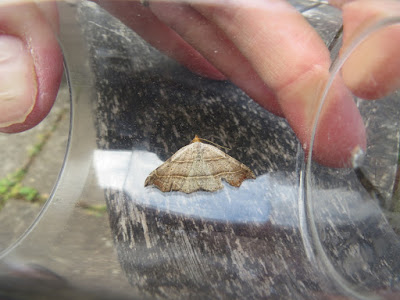Another warm night produced the expected deluge of moths. My final tally was 151 moths of 45 species, and that doesn't include a dozen or so which escaped before I could look at them. I was again bothered by the local Robins which have got even bolder, now perching on the edge of the trap and having to be shooed away. As a result I had to be up at 05.00 am to beat the Robins to their breakfast.
The commonest moths in the trap were the micros
Chrystoteucha culmella (24), and Bird-cherry Ermine (21), and the macro Heart and Dart (17).
New for the year was a
Mother of Pearl which escaped before I could photograph it, a
Dun-bar, and two
Beautiful Hook-tips.
 |
| Dun-bar (on the right) with a Heart & Dart |
 |
| Beautiful Hook-tip |
Several species were new to the garden, and these included a male
Vapourer. I have often seen small orangey-brown moths flying chaotically past at Morton Bagot and had concluded that they were probably Vapourers searching for a wingless female to mate with. So I was delighted to finally get a good look at one.
 |
| Vapourer |
Also very noteworthy was a
Black Arches. It is not only a stunning moth, one which I have seen on moth-night events, but JS informed me they normally appear until late July, so its a good record.
 |
| Black Arches |
Next we come to several macros which were probably lifers for me. I certainly can't recall seeing any of them before. The best was a
Blackneck. I actually knew exactly what it was as soon as I saw it, having seen pictures of them in magazines. I later discovered that JS has never seen one!
 |
| Blackneck |
One I didn't recognise, but was a stunning moth anyway, turned out to be a
Phoenix. I actually found two of them in the trap. They took a bit of identifying and I had to eliminate Water Carpet (flies in May) and Small Phoenix.
 |
| Phoenix |
Another striking one was a
Miller, although I gather from JS that he has been catching a few in recent days.
 |
| Miller |
A much scarcer moth was one of only two pug species I caught (the other was V-Pug). As usual I had no idea which species it was, so was relying on a photograph and JS's input. However even John wasn't sure and asked me if I had measured it and whether I had any other photos. Fortunately one of my photos was taken inside the lid of my catching pot and by measuring the distance between the air-holes compared to the moth I was able to confirm it had a forewing length of 8mm. This was good for both
Slender Pug and for Maple Pug.
 |
| Slender Pug |
John emailed back that he was still not sure but was now leaning towards my identification. However there may yet be another twist as John suggested I email my pictures to David Brown, the county recorder.
Inevitably several of the micros turned out to be new. The one that caused the biggest headache, partly because my photos weren't that good, turned out to be a
Juniper Webber. As is often the case with micros, the issue was trying to work out which family it was from. I had turned straight to the crambidae group assuming it was some kind of grass-veneer. I eventually discovered its image among the gelechiidae moths.
 |
| Juniper Webber (with Black Ant for scale) |
Other ticks were
Agapeta hamana, Hedya ochroleuchana, Cydia splendana, and Acentria ephemerella aka
Water Veneer. If you are really astute you may have noticed that this is the second time I have ticked Water Veneer. This is because one I had had identified by JS a month ago was a much bigger moth (poor John usually fails to get size details given to him when challenged to identify moths from my photos and it is also only fair to say that he only said that the moth showed an antler pattern similar to Water Veneer). Today's moths were tiny, and were all found dead, so arguably shouldn't be a tick anyway.
 |
| Agapeta hamana |
 |
| Hedya ochroleucana |
 |
| Cydia splendana |
 |
| Water-veneer |
One micro species I thought I might have caught was rejected by JS, mainly because the photo was so crap. Luckily I got a second chance when I caught another one in the bathroom (not that I knew what it was), and this time the photo backed me up. The species was the highly variable
Blastobasis lacticolella.
 |
| Blastobasis lacticolella |
Relegated to also rans purely because I have seen at least one before this year were some excellent moths such as Poplar Hawkmoth, four Coronets, Clouded Border, Peppered Moth, Spectacle, Buff-tip, Sycamore, Marbled Minor ag, and Dark Arches.
During the day I also added a new butterfly to the garden list, a
Marbled White. The Buddleia is now starting to flower and is proving a great attraction to the local butterflies.
 |
| Marbled White |
The bees in the bee hotel are also causing headaches, but that'll be covered in another posting.















No comments:
Post a Comment